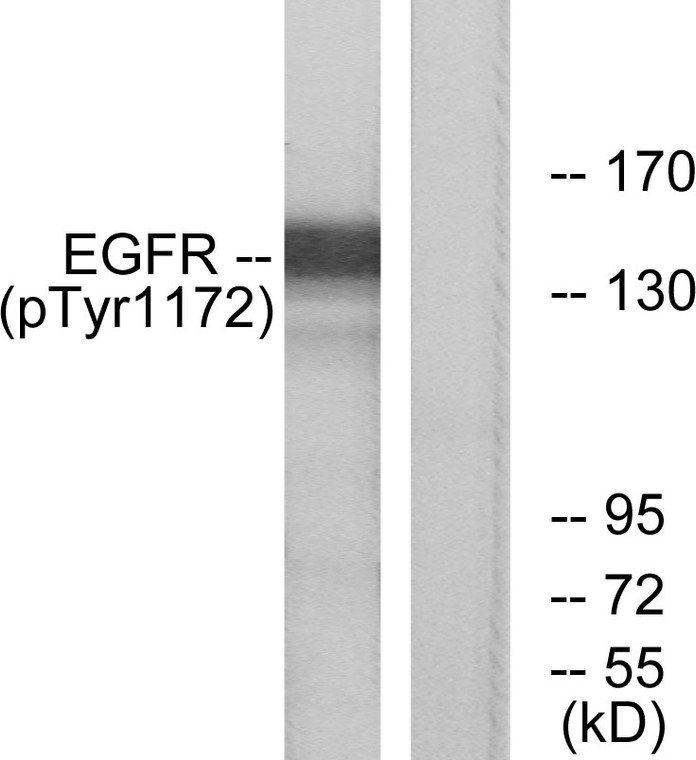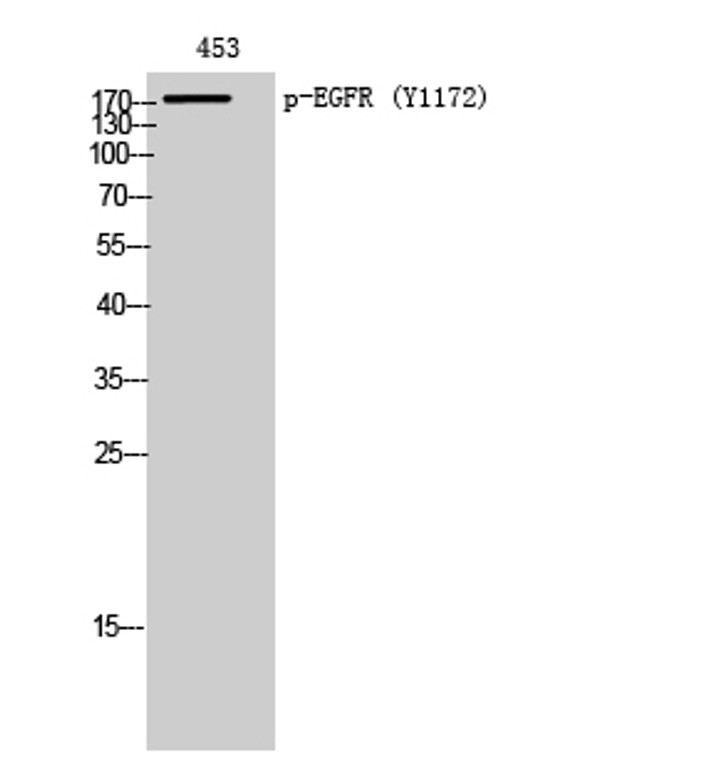| Host: |
Rabbit |
| Applications: |
WB/ELISA |
| Reactivity: |
Human/Mouse/Rat |
| Note: |
STRICTLY FOR FURTHER SCIENTIFIC RESEARCH USE ONLY (RUO). MUST NOT TO BE USED IN DIAGNOSTIC OR THERAPEUTIC APPLICATIONS. |
| Short Description: |
Rabbit polyclonal antibody anti-Phospho-Epidermal growth factor receptor-Tyr1172 (1139-1188 aa) is suitable for use in Western Blot and ELISA research applications. |
| Clonality: |
Polyclonal |
| Conjugation: |
Unconjugated |
| Isotype: |
IgG |
| Formulation: |
Liquid in PBS containing 50% Glycerol, 0.5% BSA and 0.02% Sodium Azide. |
| Purification: |
The antibody was affinity-purified from rabbit antiserum by affinity-chromatography using epitope-specific immunogen. |
| Concentration: |
1 mg/mL |
| Dilution Range: |
WB 1:500-1:2000ELISA 1:10000 |
| Storage Instruction: |
Store at-20°C for up to 1 year from the date of receipt, and avoid repeat freeze-thaw cycles. |
| Gene Symbol: |
EGFR |
| Gene ID: |
1956 |
| Uniprot ID: |
EGFR_HUMAN |
| Immunogen Region: |
1139-1188 aa |
| Specificity: |
Phospho-EGFR (Y1172) Polyclonal Antibody detects endogenous levels of EGFR protein only when phosphorylated at Y1172. |
| Immunogen: |
The antiserum was produced against synthesized peptide derived from the human EGFR around the phosphorylation site of Tyr1172 at the amino acid range 1139-1188 |
| Post Translational Modifications | Phosphorylated on Tyr residues in response to EGF. Phosphorylation at Ser-695 is partial and occurs only if Thr-693 is phosphorylated. Phosphorylation at Thr-678 and Thr-693 by PRKD1 inhibits EGF-induced MAPK8/JNK1 activation. Dephosphorylation by PTPRJ prevents endocytosis and stabilizes the receptor at the plasma membrane. Autophosphorylation at Tyr-1197 is stimulated by methylation at Arg-1199 and enhances interaction with PTPN6. Autophosphorylation at Tyr-1092 and/or Tyr-1110 recruits STAT3. Dephosphorylated by PTPN1 and PTPN2. Monoubiquitinated and polyubiquitinated upon EGF stimulation.which does not affect tyrosine kinase activity or signaling capacity but may play a role in lysosomal targeting. Polyubiquitin linkage is mainly through 'Lys-63', but linkage through 'Lys-48', 'Lys-11' and 'Lys-29' also occurs. Deubiquitination by OTUD7B prevents degradation. Ubiquitinated by RNF115 and RNF126. Ubiquitinated by ZNRF1 or CBL at different lysines in response to EGF stimulation.leading to recruitment of the ESCRT machinery and subsequent degradation in the lysosomes. Deubiquitinated by UCHL1 leading to the inhibition of its degradation. Palmitoylated on Cys residues by ZDHHC20. Palmitoylation inhibits internalization after ligand binding, and increases the persistence of tyrosine-phosphorylated EGFR at the cell membrane. Palmitoylation increases the amplitude and duration of EGFR signaling. Methylated. Methylation at Arg-1199 by PRMT5 stimulates phosphorylation at Tyr-1197. |
| Function | Receptor tyrosine kinase binding ligands of the EGF family and activating several signaling cascades to convert extracellular cues into appropriate cellular responses. Known ligands include EGF, TGFA/TGF-alpha, AREG, epigen/EPGN, BTC/betacellulin, epiregulin/EREG and HBEGF/heparin-binding EGF. Ligand binding triggers receptor homo- and/or heterodimerization and autophosphorylation on key cytoplasmic residues. The phosphorylated receptor recruits adapter proteins like GRB2 which in turn activates complex downstream signaling cascades. Activates at least 4 major downstream signaling cascades including the RAS-RAF-MEK-ERK, PI3 kinase-AKT, PLCgamma-PKC and STATs modules. May also activate the NF-kappa-B signaling cascade. Also directly phosphorylates other proteins like RGS16, activating its GTPase activity and probably coupling the EGF receptor signaling to the G protein-coupled receptor signaling. Also phosphorylates MUC1 and increases its interaction with SRC and CTNNB1/beta-catenin. Positively regulates cell migration via interaction with CCDC88A/GIV which retains EGFR at the cell membrane following ligand stimulation, promoting EGFR signaling which triggers cell migration. Plays a role in enhancing learning and memory performance. Plays a role in mammalian pain signaling (long-lasting hypersensitivity). Isoform 2 may act as an antagonist of EGF action. (Microbial infection) Acts as a receptor for hepatitis C virus (HCV) in hepatocytes and facilitates its cell entry. Mediates HCV entry by promoting the formation of the CD81-CLDN1 receptor complexes that are essential for HCV entry and by enhancing membrane fusion of cells expressing HCV envelope glycoproteins. |
| Protein Name | Epidermal Growth Factor ReceptorProto-Oncogene C-Erbb-1Receptor Tyrosine-Protein Kinase Erbb-1 |
| Database Links | Reactome: R-HSA-1227986Reactome: R-HSA-1236382Reactome: R-HSA-1236394Reactome: R-HSA-1250196Reactome: R-HSA-1251932Reactome: R-HSA-1257604Reactome: R-HSA-177929Reactome: R-HSA-179812Reactome: R-HSA-180292Reactome: R-HSA-180336Reactome: R-HSA-182971Reactome: R-HSA-1963640Reactome: R-HSA-1963642Reactome: R-HSA-212718Reactome: R-HSA-2179392Reactome: R-HSA-2219530Reactome: R-HSA-445144Reactome: R-HSA-5637810Reactome: R-HSA-5638303Reactome: R-HSA-5673001Reactome: R-HSA-6785631Reactome: R-HSA-6811558Reactome: R-HSA-8847993Reactome: R-HSA-8856825Reactome: R-HSA-8856828Reactome: R-HSA-8857538Reactome: R-HSA-8863795Reactome: R-HSA-8866910Reactome: R-HSA-9009391Reactome: R-HSA-9013507Reactome: R-HSA-9609690Reactome: R-HSA-9634638Reactome: R-HSA-9664565Reactome: R-HSA-9665348Reactome: R-HSA-9665686Reactome: R-HSA-9820960 |
| Cellular Localisation | Cell MembraneSingle-Pass Type I Membrane ProteinEndoplasmic Reticulum MembraneGolgi Apparatus MembraneNucleus MembraneEndosomeEndosome MembraneNucleusIn Response To EgfTranslocated From The Cell Membrane To The Nucleus Via Golgi And ErEndocytosed Upon Activation By LigandColocalized With Gper1 In The Nucleus Of Estrogen Agonist-Induced Cancer-Associated Fibroblasts (Caf)Isoform 2: Secreted |
| Alternative Antibody Names | Anti-Epidermal Growth Factor Receptor antibodyAnti-Proto-Oncogene C-Erbb-1 antibodyAnti-Receptor Tyrosine-Protein Kinase Erbb-1 antibodyAnti-EGFR antibodyAnti-ERBB antibodyAnti-ERBB1 antibodyAnti-HER1 antibody |
Information sourced from Uniprot.org
12 months for antibodies. 6 months for ELISA Kits. Please see website T&Cs for further guidance








